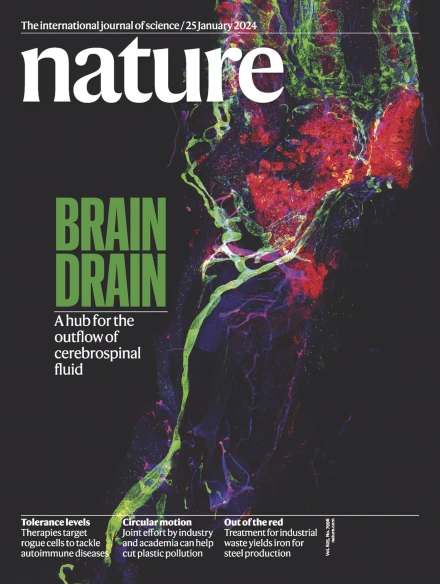NNMT inhibition in cancer-associated fibroblasts restores antitumour immunity.
IF 48.5
1区 综合性期刊
Q1 MULTIDISCIPLINARY SCIENCES
引用次数: 0
Abstract
Cancer-associated fibroblasts (CAFs) have a pivotal cancer-supportive role, yet CAF-targeted therapies are lacking1,2. Here, using spatial transcriptomics and single-cell RNA sequencing, we investigate the role of nicotinamide N-methyltransferase (NNMT) in high-grade serous ovarian cancer. Mechanistically, NNMT-induced H3K27me3 hypomethylation drives complement secretion from CAFs, attracting immunosuppressive myeloid-derived suppressor cells (MDSCs) to the tumour. Nnmt knockout in immunocompetent mice impairs tumour growth in syngeneic ovarian, breast and colon tumour models through enhanced CD8+ T cell activation. Using high-throughput screening, we develop a potent and specific NNMT inhibitor that reduces the tumour burden and metastasis in multiple mouse cancer models and restores immune checkpoint blockade efficacy by decreasing CAF-mediated recruitment of MDSCs and reinvigorating CD8+ T cell activation. Our findings establish NNMT as a central CAF regulator and a promising therapeutic target to mitigate immunosuppression in the tumour microenvironment.抑制癌症相关成纤维细胞中的NNMT可恢复抗肿瘤免疫。
癌症相关成纤维细胞(CAFs)具有关键的癌症支持作用,但CAFs靶向治疗缺乏1,2。在这里,我们利用空间转录组学和单细胞RNA测序,研究了烟酰胺n -甲基转移酶(NNMT)在高级别浆液性卵巢癌中的作用。从机制上讲,nnmt诱导的H3K27me3低甲基化驱动CAFs的补体分泌,吸引免疫抑制性髓源性抑制细胞(MDSCs)进入肿瘤。在免疫功能正常小鼠中敲除Nnmt可通过增强CD8+ T细胞激活,损害同基因卵巢、乳腺和结肠肿瘤模型中的肿瘤生长。通过高通量筛选,我们开发了一种有效的特异性NNMT抑制剂,可以减少多种小鼠癌症模型中的肿瘤负担和转移,并通过减少cafc介导的MDSCs募集和重新激活CD8+ T细胞激活来恢复免疫检查点阻断的功效。我们的研究结果表明,NNMT是一种中心CAF调节剂,也是一种有希望减轻肿瘤微环境中免疫抑制的治疗靶点。
本文章由计算机程序翻译,如有差异,请以英文原文为准。
求助全文
约1分钟内获得全文
求助全文
来源期刊

Nature
综合性期刊-综合性期刊
CiteScore
90.00
自引率
1.20%
发文量
3652
审稿时长
3 months
期刊介绍:
Nature is a prestigious international journal that publishes peer-reviewed research in various scientific and technological fields. The selection of articles is based on criteria such as originality, importance, interdisciplinary relevance, timeliness, accessibility, elegance, and surprising conclusions. In addition to showcasing significant scientific advances, Nature delivers rapid, authoritative, insightful news, and interpretation of current and upcoming trends impacting science, scientists, and the broader public. The journal serves a dual purpose: firstly, to promptly share noteworthy scientific advances and foster discussions among scientists, and secondly, to ensure the swift dissemination of scientific results globally, emphasizing their significance for knowledge, culture, and daily life.
 求助内容:
求助内容: 应助结果提醒方式:
应助结果提醒方式:


